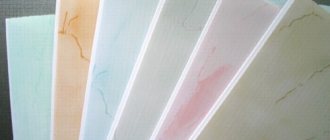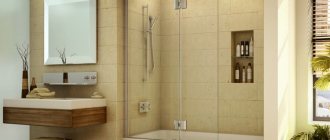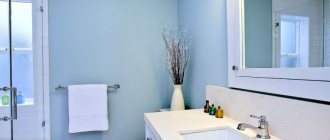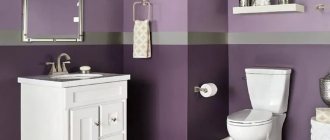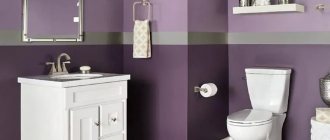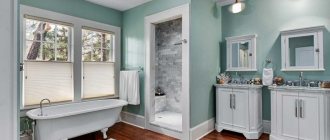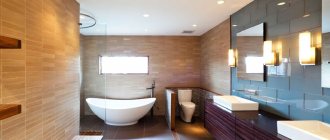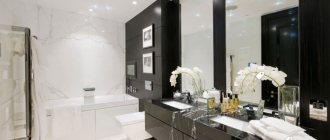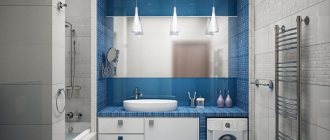The walls in the bathroom can be decorated with tiles, mosaics, washable wallpaper, plastic panels, or paint. Painting walls in the bathroom is becoming increasingly widespread and popular due to the fact that this option is cheap and provides wide scope for the use of design, selection of colors, texture of the material, drawing a picture or an ornamental pattern.
Painted walls are one of the most economical options for finishing a bathroom.
Why you should paint your bathroom walls
The most convenient method of proving the benefits of painting bathroom walls is to refute some persistent stereotypes and misconceptions that have developed regarding this finishing treatment of interior surfaces.
- Stereotype one: “The appearance, after processing, using coloring materials, is not presentable enough, gray and dull.” A similar opinion arose back in Soviet times, when, for reasons of saving public funds, the internal walls of hospitals, clinics, kindergartens, and schools were painted in faded, ugly colors, using the most affordable dye. This historical fact has created a strong association between this type of processing and dullness, sameness and mustiness. The stereotype is broken after viewing examples of successful work made using modern design approaches and materials. The situation has changed dramatically - now the paint is used to decorate bathrooms in a wide range of decorative styles and combines perfectly with both the elaborate openwork of Rococo and the bright contrast of Art Nouveau.
In fact, paint is just the material with which you can create an original and unique bathroom design - Stereotype two: “Painted walls are harmful to the body.” With the correct selection of paint, this statement loses its former relevance. High-quality water-based dyes are created from non-toxic materials.
Paint can be good or not, just like tiles, wallpaper or plastic. - Stereotype three: “The walls become covered with cracks and mold and mildew grow on them.” It also all depends on the quality of the paint. If it contains fungicidal and algaecidal compounds, it is not at all afraid of the fungus.
Cracks occur primarily due to poor-quality plaster or structural defects in the walls.
Should I resort to budget-friendly repair methods?
When the coating is in satisfactory condition, a light refinishing of the paintwork can be carried out. This will be very budget-friendly, but you need to know the type of paint, because there is often a mismatch of colors and compositions. If the old coating was applied by whitewashing, you can renew it, but these measures may not last long. The question may arise, “How to whitewash the ceiling in the bathroom?” Lime and chalk mortars are used for whitewashing. And at the same time, one excludes the use of the other, that is, chalk mortar cannot be applied to a whitewashed ceiling with lime. Therefore, it is better to cover the ceiling with water-based paint than to whitewash the ceiling in the bathroom.
Pros and cons of painted walls
Finishing a bathroom by painting has its own specific advantages and disadvantages.
Advantages:
- The material is cheap and accessible. When treating a bathroom with tiles and painting, the last method will be cheaper and more convenient.
- Simplicity and ease of use, ease of care. The coating is fairly uniform and easy to care for by periodically wiping the surface with a damp cloth or brush. It is not subject to significant contamination and is easy to wipe off.
- The finishing method by painting provides sufficient scope for the implementation of all kinds of design ideas. If you have a certain talent, you can paint full-fledged paintings and panels in the room, using various shades of the entire color palette, applying ornaments, patterns and thematic designs.
- The possibility of using specific and original decorative methods of painting, combining with other types of finishing: tiles, ceramic tiles, with elements and structures made of plastic, with other metal and ceramic materials.
Flaws:
- Less durability compared to tiles.
- Places constantly exposed to water: shower stalls, places near the sink, are not recommended to be painted.
- A painted surface is more susceptible to mechanical stress.
Surface preparation
Before starting whitewashing, as well as before all finishing work, you need to carefully prepare the surface of the walls and ceiling. To do this, first of all you need to clean and then wash off the layer of old whitewash with warm water.
If the old whitewash is in good condition, you can not wash it off, but simply “shade” it with a paint brush and warm water. However, this procedure requires certain skills, so if you are not a professional in whitewashing, we recommend that you wash it completely.
After the whitewash is washed off, you need to make sure that there are no cracks or potholes on the walls and ceiling. If they are found, you need to use putty, and after it dries, use a primer. When the primer has dried, the surface must be sanded. After this, the walls and ceiling can be considered ready for whitewashing.
Decorative painting methods
There are several ways to decoratively paint walls, allowing you to fully express your creative abilities and realize the most daring creative ideas.
- Changing the surface texture by applying acrylic paint over glass wallpaper.
The embossed surface of glass wallpaper “withstands” several layers of paint without losing the design
The simplest and most convenient way. The pattern remains the same, but its texture and color scheme change. It looks interesting and unusual.
- Painting over decorative plaster or combining them.
This method of wall decoration is ideal for decorating a bathroom in a classic style.
The combination of decorative plaster with coloring materials creates a unique, bright and harmonious ensemble. Most often, moisture-repellent plaster, which contains silicate, is used to create a bathroom interior. This type of plaster is durable and has a long service life: from 30 to 50 years; is completely unaffected by water and completely harmless to health. Plasters based on mineral compounds or acrylic materials are also used.
- Decorative painting using masking tape.
Painting tape is used to limit individual areas that are painted in different colors. This coloring technique is suitable for creating both simple and complex geometric patterns.
This method allows you to apply various geometric lines: circles, squares, strict graphic patterns. The lines come out smooth and do not blur. It is done as follows: first we paint the surface, then, on the place where the line is supposed to be drawn, apply masking tape. On top of it, in an additional layer, paint of a different color or shade is applied. After it dries, the tape is removed. The transition of colors, depending on the style used, can be made sharp or smooth.
- Decorative finishing of the bathroom using stencil painting also looks no less impressive.
The technology is very simple - first the wall is covered with a base layer of paint, and then the desired decorative pattern is applied through a stencil.
You can use store-bought or homemade stencils made of plastic or linoleum.
- The use of paints with a relief texture of the material.
You can create any texture on relief paint using a hard brush.
Beautiful, durable, moisture and mechanical impact resistant material. An additional advantage of using this type of dye is that it helps level the surface. The disadvantage is a significantly higher cost. It is applied with special brushes or a paint roller, allowing you to create original, effective patterns and designs.
- Other original ways.
How to change the color of whitewash
By introducing dye, you can achieve any shade. Since the walls and ceiling do not have to be white, like in a hospital. Previously, only one dye was used - blue. Ignorance that whitewashing can be done using certain, suitable pigments, which, above all, made the walls typically white, without an ounce of imagination.
To make lime whitewash colored, you need to add an alkali-resistant pigment to the finished solution. Liquid will not work, as the lime will simply dissolve it! The following colors are used to give different shades:
- chromium oxide;
- red lead;
- ocher;
- ultramarine;
- umber;
- soot.
It should be taken into account that the more pigment in the lime mortar, the worse the strength of the surface.
Chalk, unlike lime, can be tinted with both liquid and dry pigments. This is easy to do: just add a dye of the desired shade to the solution. You just need to keep in mind that when wet the color is richer than when dry. Therefore, it won’t hurt to “paint” the surface again, after complete drying.
Among the significant disadvantages of colored chalk whitewash, it should be noted that it is easy to get dirty when interacting with it. In addition, the room must be dry, without dampness or temperature changes.
What paints are suitable for finishing a bathroom?
Moisture resistance, vapor tightness, resistance to fungal diseases and mold, safety for life, compliance with the style of the interior - these are the main conditions that must be met when deciding what to paint the walls in the bathroom instead of tiles.
The most widespread are water-based dyes created on the basis of micropolymer compounds diluted with water. They are characterized by low cost, durability, resistance to moisture and temperature.
Among the “water-based” paints, the most common are latex acrylic paints, which have good resistance to water.
The actual water-based paints used can be divided into several types:
- silicate;
- acrylic;
- silicone;
- chlorinated rubber;
- alkyd;
- oil
Silicone mixtures are at the top of the ranking of the most expensive paints. They are a type of vapor-permeable composition, therefore almost ideal for “damp” walls
Not all of these types are recommended for use. It is most preferable to use water-based acrylic and silicone paints for baths, which, when evaporated, form a durable, moisture-resistant and bactericidal protective film on the surface. They dry quickly and do not have a strong odor. They contain no toxic materials.
Any paint must be thoroughly mixed before use.
What to look for when choosing paint?
How to choose paint in a store
To ensure that the repair process goes as smoothly as possible, special attention is paid to the quality of the paint, because the final result of the repair directly depends on this. You should also know that high-quality products cannot be very cheap and it is simply not prudent to “rush” to any tempting offers at a good price.
How to make a ceiling in a bathroom? Recommendations for choosing material and installation technology
If you save on paint, you can make a mistake in the future, because cheap water-based paint for your bathroom will be short-lived and need constant updating. Consequently, the overall price will be higher.
Advice: Before choosing, you should read the product documents. In most cases, counterfeit products do not have accompanying documents. And, as a rule, conscientious sellers will present at least some documents, and in large stores such documentation must be mandatory.
Choice of color and gloss
The main factors when choosing a matte or glossy finish are: the size of the room and the design of the furnishings, the possibility of its harmonious combination with the style.
Matte coating
Matte gloss is most often used when painting walls in spacious rooms. It is less bright, but more versatile. Smoothes and blurs the outlines of the bathroom, makes the room more comfortable and helps to visually reduce it. Matte walls go well with classic interior styles, pastel colors and smooth lines.
Matte bathroom walls in French Provence style
Applying a matte gloss coating to the walls allows you to hide unevenness and various surface defects.
Glossy surface
It looks more impressive, but even small wall irregularities, stains and stains are especially noticeable with gloss. A room with a glossy shine requires much more effort to maintain it in decent condition. Ideally harmonizes with such interior styles as: modern, minimalism, expressionist movements. It is appropriate to use glossy paints in rooms with large mirror surfaces.
Gloss on the walls will correct the shortcomings of the room and make the bathroom space visually larger
Glossy paints are less susceptible to mechanical stress compared to matte ones.
Color spectrum
When deciding what and how to paint the walls in the bathroom, the choice of color is extremely important, since its influence on the psychosomatic state of a person is undeniable.
When decorating a bath, the most common colors are those associated with the sea and sea waves: various shades of blue and green. This color promotes peace and has a calming, relaxing effect.
The pleasant turquoise color of the walls will remind you of vacation and relaxation at sea
Green coloring of the walls will bring freshness and summer mood to the interior
If the room is small, designers recommend using colors in a light spectrum, as they expand its visual perception. But you should not use exclusively white colors - this may lead to not entirely pleasant associations. White color - must be diluted with warmer and gentler shades or combined with bright decorative elements.
White is a universal color for decorating a small bathroom
The red and white combination will appeal to lovers of a bright and rich interior.
Contrasting colors are often used in the interior of spacious bathrooms. This technique is used to give greater emphasis to individual elements of the room, to highlight and delimit zonal boundaries. A shower stall in an aggressive color scheme looks impressive against a wall painted in calm, pastel colors.
Different colors can be used to zoning space or emphasizing individual functional areas
Depending on the style, it is permissible to use dark colors, even black, but at the same time, it is necessary to strictly maintain proportions.
In a fairly spacious bathroom, gray walls look good, against which white plumbing stands out.
Which color do you prefer?
If a detailed design of the room is developed during the renovation process, choosing a paint color will not be difficult, because it will be indicated in the project. Otherwise, you will have to select the paint yourself. Of course, you can give in to your own taste preferences, but you should know that for small rooms, which in most cases is the bathroom, it is better to choose light colors and shades. It is not necessary to cover the ceiling white; you can use various shades of beige, blue, green, lilac, etc.
Advice: If the desired shade is selected, then it is better not to resort to tinting yourself, but to use the tinting services in a hardware store, this will make it possible to create the required color quickly and efficiently, and, if necessary, additionally order the missing amount of similar paint.
Paints that are not recommended for painting in the bathroom
- Do not use emulsions containing PVA in rooms with high humidity! When interacting with water, this material becomes unsafe for the body.
- It is not recommended to decorate a bathroom using oil paints. They have a persistent, unpleasant odor that does not disappear for a long time. They take a long time to dry and are very susceptible to cracking.
- It is also not recommended to use alkyd enamels. Despite their visual appeal, alkyd enamels have a specific, persistent odor.
The bathroom is one of those rooms on which you should not skimp on decoration.
How is the bathroom different from other rooms?
Bathroom painting
Before choosing paint for finishing the ceiling in the bathroom, you need to understand how this room differs, for example, from the kitchen or living room.
- Firstly, the bathroom is one of the most visited places in the room. And, as a rule, it has a small area.
- Secondly, the indoor microclimate often changes. The reason for this is the release of water vapor, the operation of forced ventilation and heating devices (“warm floors,” towel dryers, etc.).
- Thirdly, all finishing materials must have good moisture resistance and antibacterial properties. Since a warm and humid room is an ideal environment for the development of microbes and mold.
Knowing the specifics of the bathroom, you can easily select the material for ceiling repair. Therefore, the paint must meet requirements such as: moisture resistance, neutral odor, antibacterial and antifungal properties and a breathable treated surface.
Photo ideas for painting walls in the bathroom
Consumption of paint and additional materials
The average consumption of any material is indicated on the packaging. To calculate how much product to purchase, you need to know the area and number of layers that will be made. Consumption may increase if minor defects need to be covered.
The level of hiding power of the paint also affects the consumption.
To calculate how much product to purchase, you need to know the area and number of layers that will be made.
Painting mistakes
Even after studying the manual and recommendations of wall painting experts, many make mistakes. Because of them, you can renew the walls in the bathroom within a year.
The most common mistakes when painting a surface are:
- Painting walls without prior preparation. Even if the walls seem smooth and clean, they still need to be prepared. How to prepare walls for painting is described above.
- No primer. Often, most people think that priming walls is unnecessary because the walls are clean. Over time, due to the lack of a primer layer, fungus appears and the paint peels off from the surface.
- The paint was not prepared correctly. Before preparing a paint solution, you must carefully read the preparation instructions. The prepared mixture should be neither thick nor liquid, but of medium consistency, without lumps.
- Indiscriminate application of finishing material. The method of painting is very important; the type of coating after drying depends on it. Movements when painting should be directed in one direction and be either vertical or horizontal. Chaotic movements after drying are visible.
It is better to apply the next layer of paint perpendicular to the previous one, then the dried walls will be well covered.
- Violation of the drying time. On the paint packaging, each manufacturer indicates the drying time of the layers. Even if the finish seems dry to the touch, it is better to wait the specified hour so that when applying the second layer, the first does not end up on the roller.
Protect the paint from direct contact with water
Painting a bathtub yourself requires additional protection of the walls from splashes. You can place tiles above the bathtub and sink. I suggested to my friend to install shockproof glass.
It is almost invisible and can be easily installed using dowels, or on brackets if the tub is not tightly against the wall due to the pipes.
Vadik already knew how to paint a bathtub with his own hands. Protecting the most vulnerable sections of the walls did not take much time. You can use old tiles. Apply paint for restoration.
For pipes, it is better to build a box and cover it in the color of the walls.
